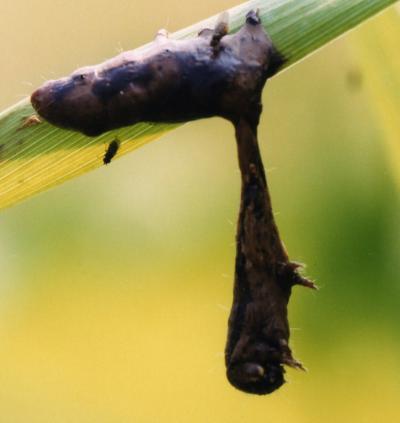We're open daily! View holiday hours
Science News
Viral Rain
September 8, 2011

Imagine this pitch for a natural horror movie… A virus infects its host, the zombie-like host climbs a tree and begins to melt from the inside out. As the dead host liquefies, the virus drops like rain from on high, spreading itself to more victims.
Scary, right? And also true. True for gypsy moth caterpillars (and only gypsy moth caterpillars), that is.
Scientists have known about these sickened caterpillars for a century. In fact, the infected behavior occurs so consistently that it inspired the term “Wipfelkrankheit,” or “tree top disease,” to describe the virus that caused it. Although well-known, the behavior has puzzled scientists for decades, in terms of how this virus could influence its host’s mind.
Normal gypsy moth caterpillars indeed spend their time in the trees, feeding at night and then hiding in a tree’s bark crevices during the day or climbing down to the soil to avoid predators. But the infected caterpillars head for the tree tops in broad daylight, influenced by the virus.
Kelli Hoover from Penn State figured the changed behavior had something to do with a hormone, 20E, which regulates molting in the caterpillar. Caterpillars descend trees to molt, so something in the virus must block the hormone.
Enter a specific gene in the virus called egt. Ed Yong reports in his Discover blog:
When Hoover and [Penn State colleague Michael] Grove removed it, the virus still managed to kill its caterpillars, but it couldn’t make them climb. Instead, the insects perished at a lowly position at the bottom of their containers. When Hoover and Grove reinserted the gene into their altered virus, they restored its ability to change the caterpillars’ behavior.
Nature News describes how this theory answers the puzzle quite well:
The work provides a neat explanation for how a viral gene can affect caterpillar behavior. “Interfering with the hormonal system is the most elegant way to influence complex traits such as behavior,” says Hoover.
Scientists have identified other instances in which parasites and pathogens manipulate host behavior to enhance transmission to new victims. We wrote about ant-zombifying fungi a few months ago, and the parasite Toxoplasma was in the news a couple of weeks ago as scientists found that toxo-infected rats become sexually aroused by cat urine. (Shudder.)
Creepy, right? Who knows how we’re affected by viruses and the like… Jim Slavicek, co-author of the new paper published today in Science, muses, “Maybe this is why we go to work when we have a cold.”
Image: Michael Grove